Liang Zhang
Seedance 1.5 pro: A Native Audio-Visual Joint Generation Foundation Model
Dec 23, 2025Abstract:Recent strides in video generation have paved the way for unified audio-visual generation. In this work, we present Seedance 1.5 pro, a foundational model engineered specifically for native, joint audio-video generation. Leveraging a dual-branch Diffusion Transformer architecture, the model integrates a cross-modal joint module with a specialized multi-stage data pipeline, achieving exceptional audio-visual synchronization and superior generation quality. To ensure practical utility, we implement meticulous post-training optimizations, including Supervised Fine-Tuning (SFT) on high-quality datasets and Reinforcement Learning from Human Feedback (RLHF) with multi-dimensional reward models. Furthermore, we introduce an acceleration framework that boosts inference speed by over 10X. Seedance 1.5 pro distinguishes itself through precise multilingual and dialect lip-syncing, dynamic cinematic camera control, and enhanced narrative coherence, positioning it as a robust engine for professional-grade content creation. Seedance 1.5 pro is now accessible on Volcano Engine at https://console.volcengine.com/ark/region:ark+cn-beijing/experience/vision?type=GenVideo.
Ask, Answer, and Detect: Role-Playing LLMs for Personality Detection with Question-Conditioned Mixture-of-Experts
Dec 09, 2025Abstract:Understanding human personality is crucial for web applications such as personalized recommendation and mental health assessment. Existing studies on personality detection predominantly adopt a "posts -> user vector -> labels" modeling paradigm, which encodes social media posts into user representations for predicting personality labels (e.g., MBTI labels). While recent advances in large language models (LLMs) have improved text encoding capacities, these approaches remain constrained by limited supervision signals due to label scarcity, and under-specified semantic mappings between user language and abstract psychological constructs. We address these challenges by proposing ROME, a novel framework that explicitly injects psychological knowledge into personality detection. Inspired by standardized self-assessment tests, ROME leverages LLMs' role-play capability to simulate user responses to validated psychometric questionnaires. These generated question-level answers transform free-form user posts into interpretable, questionnaire-grounded evidence linking linguistic cues to personality labels, thereby providing rich intermediate supervision to mitigate label scarcity while offering a semantic reasoning chain that guides and simplifies the text-to-personality mapping learning. A question-conditioned Mixture-of-Experts module then jointly routes over post and question representations, learning to answer questionnaire items under explicit supervision. The predicted answers are summarized into an interpretable answer vector and fused with the user representation for final prediction within a multi-task learning framework, where question answering serves as a powerful auxiliary task for personality detection. Extensive experiments on two real-world datasets demonstrate that ROME consistently outperforms state-of-the-art baselines, achieving improvements (15.41% on Kaggle dataset).
ChartEditor: A Reinforcement Learning Framework for Robust Chart Editing
Nov 19, 2025Abstract:Chart editing reduces manual effort in visualization design. Typical benchmarks limited in data diversity and assume access to complete chart code, which is seldom in real-world scenarios. To address this gap, we present ChartEditVista, a comprehensive benchmark consisting of 7,964 samples spanning 31 chart categories. It encompasses diverse editing instructions and covers nearly all editable chart elements. The inputs in ChartEditVista include only the original chart image and natural language editing instructions, without the original chart codes. ChartEditVista is generated through a fully automated pipeline that produces, edits, and verifies charts, ensuring high-quality chart editing data. Besides, we introduce two novel fine-grained, rule-based evaluation metrics: the layout metric, which evaluates the position, size and color of graphical components; and the text metric, which jointly assesses textual content and font styling. Building on top of ChartEditVista, we present ChartEditor, a model trained using a reinforcement learning framework that incorporates a novel rendering reward to simultaneously enforce code executability and visual fidelity. Through extensive experiments and human evaluations, we demonstrate that ChartEditVista provides a robust evaluation, while ChartEditor consistently outperforms models with similar-scale and larger-scale on chart editing tasks.
Multi-Granularity Mutual Refinement Network for Zero-Shot Learning
Nov 11, 2025Abstract:Zero-shot learning (ZSL) aims to recognize unseen classes with zero samples by transferring semantic knowledge from seen classes. Current approaches typically correlate global visual features with semantic information (i.e., attributes) or align local visual region features with corresponding attributes to enhance visual-semantic interactions. Although effective, these methods often overlook the intrinsic interactions between local region features, which can further improve the acquisition of transferable and explicit visual features. In this paper, we propose a network named Multi-Granularity Mutual Refinement Network (Mg-MRN), which refine discriminative and transferable visual features by learning decoupled multi-granularity features and cross-granularity feature interactions. Specifically, we design a multi-granularity feature extraction module to learn region-level discriminative features through decoupled region feature mining. Then, a cross-granularity feature fusion module strengthens the inherent interactions between region features of varying granularities. This module enhances the discriminability of representations at each granularity level by integrating region representations from adjacent hierarchies, further improving ZSL recognition performance. Extensive experiments on three popular ZSL benchmark datasets demonstrate the superiority and competitiveness of our proposed Mg-MRN method. Our code is available at https://github.com/NingWang2049/Mg-MRN.
LLM-OREF: An Open Relation Extraction Framework Based on Large Language Models
Sep 18, 2025Abstract:The goal of open relation extraction (OpenRE) is to develop an RE model that can generalize to new relations not encountered during training. Existing studies primarily formulate OpenRE as a clustering task. They first cluster all test instances based on the similarity between the instances, and then manually assign a new relation to each cluster. However, their reliance on human annotation limits their practicality. In this paper, we propose an OpenRE framework based on large language models (LLMs), which directly predicts new relations for test instances by leveraging their strong language understanding and generation abilities, without human intervention. Specifically, our framework consists of two core components: (1) a relation discoverer (RD), designed to predict new relations for test instances based on \textit{demonstrations} formed by training instances with known relations; and (2) a relation predictor (RP), used to select the most likely relation for a test instance from $n$ candidate relations, guided by \textit{demonstrations} composed of their instances. To enhance the ability of our framework to predict new relations, we design a self-correcting inference strategy composed of three stages: relation discovery, relation denoising, and relation prediction. In the first stage, we use RD to preliminarily predict new relations for all test instances. Next, we apply RP to select some high-reliability test instances for each new relation from the prediction results of RD through a cross-validation method. During the third stage, we employ RP to re-predict the relations of all test instances based on the demonstrations constructed from these reliable test instances. Extensive experiments on three OpenRE datasets demonstrate the effectiveness of our framework. We release our code at https://github.com/XMUDeepLIT/LLM-OREF.git.
IEFS-GMB: Gradient Memory Bank-Guided Feature Selection Based on Information Entropy for EEG Classification of Neurological Disorders
Sep 18, 2025Abstract:Deep learning-based EEG classification is crucial for the automated detection of neurological disorders, improving diagnostic accuracy and enabling early intervention. However, the low signal-to-noise ratio of EEG signals limits model performance, making feature selection (FS) vital for optimizing representations learned by neural network encoders. Existing FS methods are seldom designed specifically for EEG diagnosis; many are architecture-dependent and lack interpretability, limiting their applicability. Moreover, most rely on single-iteration data, resulting in limited robustness to variability. To address these issues, we propose IEFS-GMB, an Information Entropy-based Feature Selection method guided by a Gradient Memory Bank. This approach constructs a dynamic memory bank storing historical gradients, computes feature importance via information entropy, and applies entropy-based weighting to select informative EEG features. Experiments on four public neurological disease datasets show that encoders enhanced with IEFS-GMB achieve accuracy improvements of 0.64% to 6.45% over baseline models. The method also outperforms four competing FS techniques and improves model interpretability, supporting its practical use in clinical settings.
STM3: Mixture of Multiscale Mamba for Long-Term Spatio-Temporal Time-Series Prediction
Aug 17, 2025Abstract:Recently, spatio-temporal time-series prediction has developed rapidly, yet existing deep learning methods struggle with learning complex long-term spatio-temporal dependencies efficiently. The long-term spatio-temporal dependency learning brings two new challenges: 1) The long-term temporal sequence includes multiscale information naturally which is hard to extract efficiently; 2) The multiscale temporal information from different nodes is highly correlated and hard to model. To address these challenges, we propose an efficient \textit{\textbf{S}patio-\textbf{T}emporal \textbf{M}ultiscale \textbf{M}amba} (STM2) that includes a multiscale Mamba architecture to capture the multiscale information efficiently and simultaneously, and an adaptive graph causal convolution network to learn the complex multiscale spatio-temporal dependency. STM2 includes hierarchical information aggregation for different-scale information that guarantees their distinguishability. To capture diverse temporal dynamics across all spatial nodes more efficiently, we further propose an enhanced version termed \textit{\textbf{S}patio-\textbf{T}emporal \textbf{M}ixture of \textbf{M}ultiscale \textbf{M}amba} (STM3) that employs a special Mixture-of-Experts architecture, including a more stable routing strategy and a causal contrastive learning strategy to enhance the scale distinguishability. We prove that STM3 has much better routing smoothness and guarantees the pattern disentanglement for each expert successfully. Extensive experiments on real-world benchmarks demonstrate STM2/STM3's superior performance, achieving state-of-the-art results in long-term spatio-temporal time-series prediction.
Mathematical Computation and Reasoning Errors by Large Language Models
Aug 14, 2025Abstract:Large Language Models (LLMs) are increasingly utilized in AI-driven educational instruction and assessment, particularly within mathematics education. The capability of LLMs to generate accurate answers and detailed solutions for math problem-solving tasks is foundational for ensuring reliable and precise feedback and assessment in math education practices. Our study focuses on evaluating the accuracy of four LLMs (OpenAI GPT-4o and o1, DeepSeek-V3 and DeepSeek-R1) solving three categories of math tasks, including arithmetic, algebra, and number theory, and identifies step-level reasoning errors within their solutions. Instead of relying on standard benchmarks, we intentionally build math tasks (via item models) that are challenging for LLMs and prone to errors. The accuracy of final answers and the presence of errors in individual solution steps were systematically analyzed and coded. Both single-agent and dual-agent configurations were tested. It is observed that the reasoning-enhanced OpenAI o1 model consistently achieved higher or nearly perfect accuracy across all three math task categories. Analysis of errors revealed that procedural slips were the most frequent and significantly impacted overall performance, while conceptual misunderstandings were less frequent. Deploying dual-agent configurations substantially improved overall performance. These findings offer actionable insights into enhancing LLM performance and underscore effective strategies for integrating LLMs into mathematics education, thereby advancing AI-driven instructional practices and assessment precision.
MCPToolBench++: A Large Scale AI Agent Model Context Protocol MCP Tool Use Benchmark
Aug 11, 2025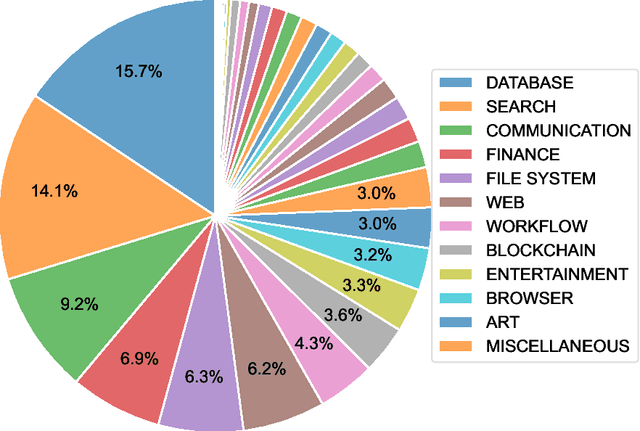

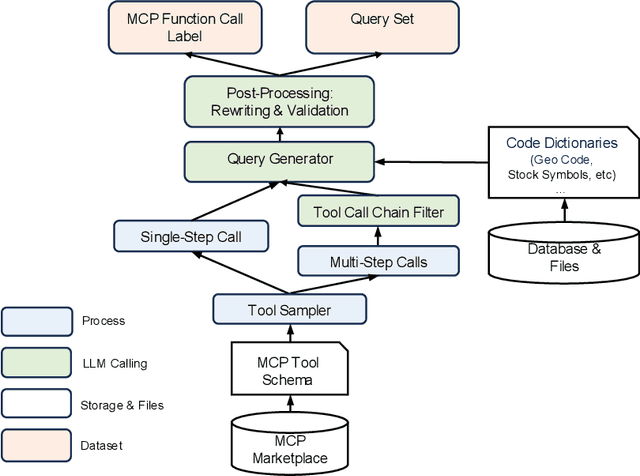
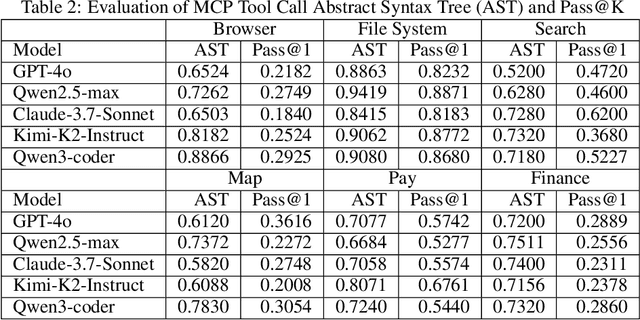
Abstract:LLMs' capabilities are enhanced by using function calls to integrate various data sources or API results into the context window. Typical tools include search, web crawlers, maps, financial data, file systems, and browser usage, etc. Integrating these data sources or functions requires a standardized method. The Model Context Protocol (MCP) provides a standardized way to supply context to LLMs. However, the evaluation of LLMs and AI Agents' MCP tool use abilities suffer from several issues. First, there's a lack of comprehensive datasets or benchmarks to evaluate various MCP tools. Second, the diverse formats of response from MCP tool call execution further increase the difficulty of evaluation. Additionally, unlike existing tool-use benchmarks with high success rates in functions like programming and math functions, the success rate of real-world MCP tool is not guaranteed and varies across different MCP servers. Furthermore, the LLMs' context window also limits the number of available tools that can be called in a single run, because the textual descriptions of tool and the parameters have long token length for an LLM to process all at once. To help address the challenges of evaluating LLMs' performance on calling MCP tools, we propose MCPToolBench++, a large-scale, multi-domain AI Agent tool use benchmark. As of July 2025, this benchmark is build upon marketplace of over 4k MCP servers from more than 40 categories, collected from the MCP marketplaces and GitHub communities. The datasets consist of both single-step and multi-step tool calls across different categories. We evaluated SOTA LLMs with agentic abilities on this benchmark and reported the results.
TOP: Time Optimization Policy for Stable and Accurate Standing Manipulation with Humanoid Robots
Aug 01, 2025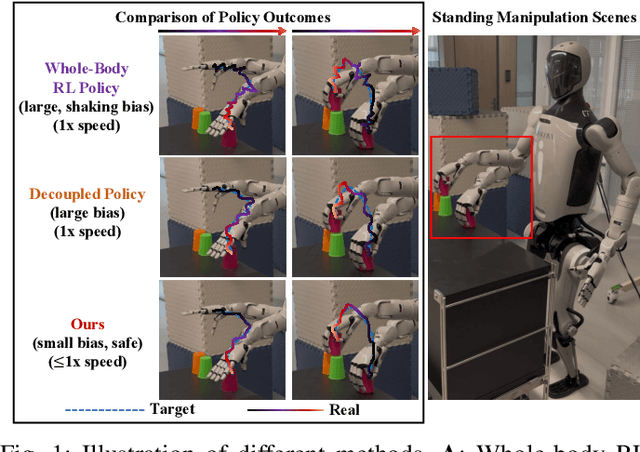
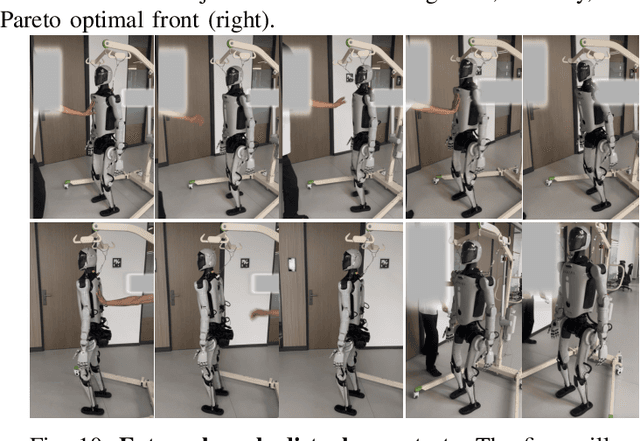
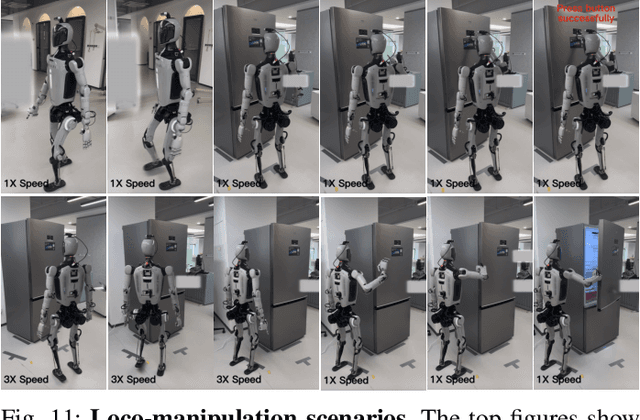
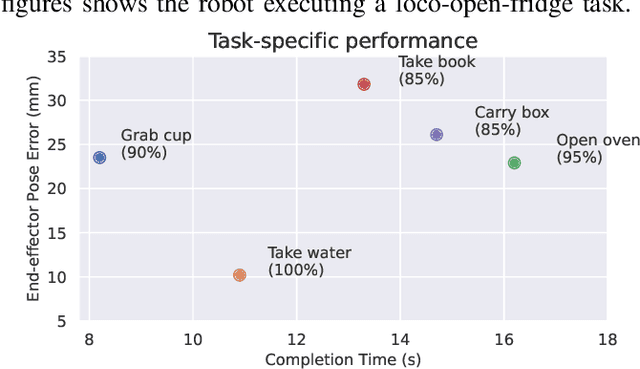
Abstract:Humanoid robots have the potential capability to perform a diverse range of manipulation tasks, but this is based on a robust and precise standing controller. Existing methods are either ill-suited to precisely control high-dimensional upper-body joints, or difficult to ensure both robustness and accuracy, especially when upper-body motions are fast. This paper proposes a novel time optimization policy (TOP), to train a standing manipulation control model that ensures balance, precision, and time efficiency simultaneously, with the idea of adjusting the time trajectory of upper-body motions but not only strengthening the disturbance resistance of the lower-body. Our approach consists of three parts. Firstly, we utilize motion prior to represent upper-body motions to enhance the coordination ability between the upper and lower-body by training a variational autoencoder (VAE). Then we decouple the whole-body control into an upper-body PD controller for precision and a lower-body RL controller to enhance robust stability. Finally, we train TOP method in conjunction with the decoupled controller and VAE to reduce the balance burden resulting from fast upper-body motions that would destabilize the robot and exceed the capabilities of the lower-body RL policy. The effectiveness of the proposed approach is evaluated via both simulation and real world experiments, which demonstrate the superiority on standing manipulation tasks stably and accurately. The project page can be found at https://anonymous.4open.science/w/top-258F/.
 Add to Chrome
Add to Chrome Add to Firefox
Add to Firefox Add to Edge
Add to Edge